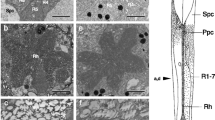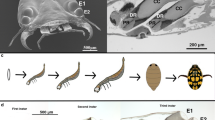Abstract
The energy dependence of the pupil pigment-migrations in the fly Musca domestica was studied in live animals, using optical techniques and nitrogen-gas induced anoxia. The results obtained can be summarized in 3 points:
-
1.
Energy deficiency can make the pupil mechanism stop in any state, extreme or intermediate.
-
2.
Anoxia induced during intermittent stimulation makes the pupil stop in the closed state (aggregated pigment granules).
-
3.
During long-term anoxia the pupil very slowly opens (dispersal of pigment granules), irrespective of ambient intensity.
The slow anoxic opening (point 3) is more than 1000 times slower than that predicted for free diffusion of pigment granules in water. Assuming realistic values of cytoplasm viscosity, this implies that anoxia causes the pigment granules to attach to rigid structures in the cells, in analogy with the rigor state in anoxic muscles. The rigor phenomenon in the pupil mechanism prevents experimental discrimination between active and passive processes of pigment migration. Normal pupil opening has a time course which agrees reasonably with a passive diffusion process, but it is argued that an active transportation of granules away from the rhabdom is more likely in the dark adapted eye.
Similar content being viewed by others
Abbreviations
- ERG:
-
electroretinogram
References
Banister MJ, White RH (1987) Pigment migration in the compound eye of Manduca sexta: effects of light, nitrogen and carbon dioxide. J Insect Physiol 33:733–743
Beersma DGM, Hoenders BJ, Huiser AMJ, Toorn P van (1982) Refractive index of the fly rhabdomere. J Opt Soc Am 72:583–588
Blest AD, De Couet HG, Howard J, Wilcox M, Sigmund C (1984) The extrarhabdomeral cytoskeleton in photoreceptors of Diptera. I. Labile components in the cytoplasm. Proc R Soc Lond B 220:339–352
Boschek CB (1971) On the fine structure of the peripheral retina and lamina ganglionaris of the fly, Musca domestica. Z Zellforsch 118:369–409
Clark TG, Rosenbaum JL (1982) ATP-dependent aggregation in detergent-permeabilized melanophores of Fundus heteroclitus. J Cell Biol 95:330a
Daniels F, Alberty RA (1955) Physical chemistry. John Wiley & Sons, New York London Sydney
Dimitracos SA, Tsacopoulos M (1985) The recovery from a transient inhibition of the oxidative metabolism of the photoreceptors of the drone. J Exp Biol 119:165–181
Frixione E, Arechiga H, Tsutsumi V (1979) Photomechanical migrations of pigment granules along the retinula cells of the crayfish. J Neurobiol 10:573–590
Hamdorf K, Hochstrate P, Höglund G, Burbach B, Wiegand U (1988) Light activation of the sodium pump in blowfly photoreceptors. J Comp Physiol A 162:285–300
Hateren JH van (1989) Photoreceptor optics, Theory and practice. In: Stavenga DG, Hardie RC (eds) Facets of vision. Springer, Berlin, pp 74–89
Hoffmann C (1960) Belichtungspotentiale der Insekten und Sauerstoffdruck. Verh Dtsch Zool Ges 53:220–225
Horowitz BR (1981) Theoretical considerations of the retinal receptor as a waveguide. In: Enoch JM, Tobey FL Jr (eds) Vertebrate photoreceptor optics. Springer, Berlin Heidelberg New York, pp 219–300
Horridge GA, Giddings C (1971) The retina of Ephestia (Lepidoptera). Proc R Soc Lond B 179:87–95
Howard J (1984) Calcium enables photoreceptor pigment migration in a mutant fly. J Exp Biol 113:471–475
Kachar B (1985) Direct visualization of organelle movement along actin filaments dissociated from characean algae. Science 227:1355–1357
Kirschfeld K, Franceschini N (1969) Ein Mechanismus zur Steuerung des Lichtflusses in den Rhabdomeren des Komplexauges von Musca. Kybernetik 6:13–22
Kirschfeld K, Vogt K (1980) Calcium ions and pigment migration in fly photoreceptors. Naturwissenschaften 67:516–517
Luby-Phelps K, Porter KR (1982) The control of pigment migration in isolated erythrophores of Holocentrus ascensionis (Osbeck). I. Energy requirements. Cell 21:13–23
Meinecke CC (1981) The fine structure of the compound eye of the African army worm moth, Spodoptera exempta Walk. (Lepidoptera, Noctuidae). Cell Tissue Res 216:333–347
Nilsson D-E, Land MF, Howard J (1988) Optics of the butterfly eye. J Comp Physiol A 162:341–366
Nilsson D-E, Henrekson I, Järemo A-C (1989) Pupil control in compound eyes: More than one mechanism in moths. In: Singh N, Strausfeld NJ (eds) Neurobiology of sensory systems. Plenum, New York, pp 17–22
Payne R (1981) Suppression of noise in a photoreceptor by oxidative metabolism. J Comp Physiol 142:181–188
Roebroek JGH, Stavenga DG (1990) Insect pupil mechansims IV. Spectral characteristics and light intensity dependence in the blowfly, Calliphora erytrocephala. J Comp Physiol A 166:537–543
Scholey JM, Cohn SA, Ingold AL (1988) Biochemical and motile properties of sea urchin egg kinesin: Relationship to the pathway of the kinesin microtubule ATPase. In: Warner FD, McIntosh JR (eds) Cell movement Vol 2: Kinesin dynein and MT dynamics. Alan Liss, New York, pp 307–320
Smakman JGJ, Hateren JH van, Stavenga DG (1984) Angular sensitivity of blowfly photoreceptors: Intracellular measurements and wave-optical predictions. J Comp Physiol A 155:239–247
Snyder AW, Love JD (1983) Optical waveguide theory. Chapman and Hall, London New York
Stavenga DG (1975) Optical qualities of the fly eye: an approach from the side of geometrical physical and waveguide optics. In: Snyder AW, Menzel P (eds) Photoreceptor optics. Springer, Berlin Heidelberg New York, pp 126–144
Stavenga DG (1979) Pseudopupils of compound eyes. In: Autrum H (ed) Vision in invertebrates (Handbook of sensory physiology, Vol VII/6A). Springer, Berlin Heidelberg New York, pp 357–139
Stavenga DG (1989) Pigments in compound eyes. In: Stavenga DG, Hardie RC (eds) Facets of vision. Springer, Berlin, pp 152–172
Welsch B (1977) Ultrastruktur und funktioneile Morphologie der Augen des Nachtfalters Deilephila elpenor (Lepidoptera, Sphingidae). Cytobiologie 14:378–400
Weyrauther E (1988) The influence of temperature and oxygen on the photomechanical system of the mealmoth eye. J Comp Physiol B 158:421–429
Wilcox M, Franceschini N (1984) Stimulated drug uptake in a photoreceptor cell. Neurosci Lett 50:187–192
Author information
Authors and Affiliations
Rights and permissions
About this article
Cite this article
Jonson, A.C.J., Nilsson, D.E. Effects of energy deprivation on the fly pupil mechanism: evidence for a rigor state. J Comp Physiol A 174, 701–706 (1994). https://doi.org/10.1007/BF00192719
Accepted:
Issue Date:
DOI: https://doi.org/10.1007/BF00192719




